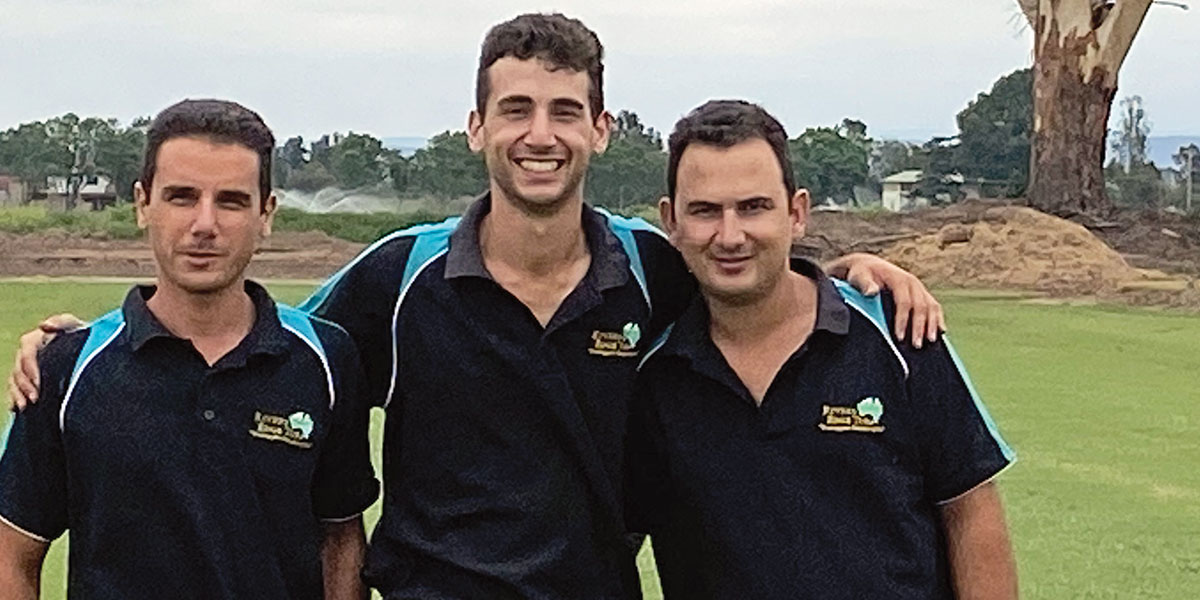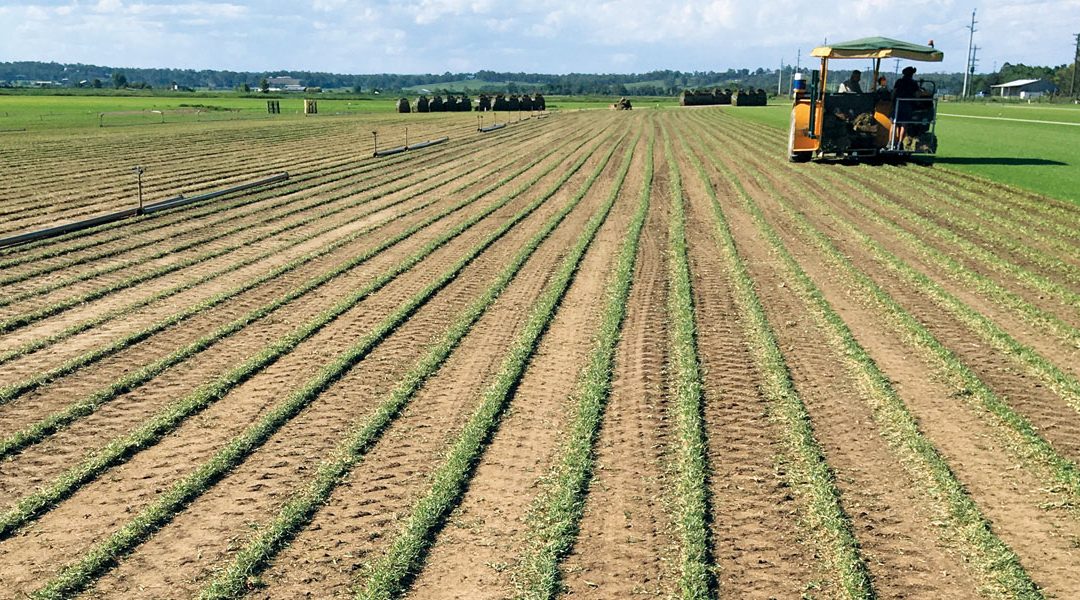AT A GLANCE
Growers: Rivers Edge Turf, Jim and Mary Mifsud and sons Jonathan, Edward and Michael Mifsud
Property: Wilberforce, New South Wales
Focus: Making a big impact with a small farm
Market: Commercial, trade and retail sales of Sapphire Soft Leaf Buffalo, Nara Native Zoysia, Kikuyu and Santa Ana Couch.

After returning to Australia, Jim had a yarn over the fence with a turf growing neighbour who praised its resilience – so he decided to test the waters by growing Kikuyu and Couch on contract.
Three generations of Mifsuds have always thought differently, unconventionally, or from a new perspective in terms of farming. Farming ventures have ranged from vegetable production from the 1950s in New South Wales to farming vegetables in China during the 1990s. Finally, turf production was the next venture to undertake and today the third generation Mifsud boys have learnt to ‘read’ the market, perform their own onfarm research and development and produce top quality turf. Sandra Godwin explains.

Above: Third generation Mifsud boys – Johnathan, Edward and Michael.
Second generation farmer Jim Mifsud cut his teeth growing vegetables on the fertile flats of the Hawkesbury River, 50 kilometres(km) northwest of Sydney in New South Wales (NSW).
Starting with his parents Giovanni and Venerandi, who emigrated from Malta in the 1950s, and later with his wife Mary, Jim grew cabbages, lettuce, corn, cauliflower and potatoes.
But the alluvial plains were plagued by frequent flooding – up to five times a year during the 1990s – that repeatedly swept away or ruined the crops they had laboured over and Jim began looking for an alternative.
Jim then made a change and spent the best part of six years managing a vegetable farm in China, on behalf of a joint venture backed by Australian and American investors.
Two hours from Shanghai, the farm supplied mainly broccoli and corn to Japan. Mary and their young sons Jonathan, Michael and Edward joined Jim for about 18-months.
Jonathan, who was 10 at the time, remembers it as an amazing experience, doing school lessons by distance education via audio cassette tapes in those pre-internet days and learning the language and culture.
“We saw a lot of things there you don’t see back home,” Johnathan said.
After returning to Australia, Jim had a yarn over the fence with a turf growing neighbour who praised its resilience – so he decided to test the waters by growing Kikuyu and Couch on contract.
“He gave turf a try and it flourished from there,” Jonathan said.
In 2009, Jim, Mary and Jonathan established Rivers Edge Turf. As the business grew, they were joined by Michael in 2012 and later employed the youngest brother, Edward, as operations coordinator.
The 20ha farm near Wilberforce now produces four varieties of turf: Sapphire Soft Leaf Buffalo; Nara Native Zoysia; Kikuyu and Santa Ana Couch. Turf is available in the standard 1 metre rolls or Maxi 20 square metre (m2) rolls for orders intended for large open areas and is usually harvested in the afternoon before delivery.
Jonathan said the market for their turf varied from year-to-year.
“Some years there’s more residential homeowners and in other years more commercial or landscape work,” he said.
“At the moment we’re about 70 per cent councils and commercial projects like roadsides and parks, and 30 per cent direct to homeowners. We also do a little bit of preparation for turf installation.”
Rather than submitting tenders for large contracts, Jonathan said they were mostly brought into the big jobs by landscapers with whom they regularly work.
Despite the relatively small size of the farm, the Mifsuds don’t shy away from tackling major projects – their biggest have included 25,000m2 football ovals at Kogarah and Ashfield in Sydney. And they will buy in varieties they don’t produce from other growers, if necessary.
“There’s a lot of neighbours growing different varieties,” Jonathan said.
“We try to stick to one strand of each variety because of our land size. We’ve only 20ha, which is tiny for turf, so it becomes a nightmare to keep everything segmented with too many varieties.
“Regrowth can take anywhere from 7-15 months for slower varieties, so once we’ve done a sweep through a paddock, we’re always looking further afield for more turf to meet demand.”
Rivers Edge Turf recommends Sapphire Soft Leaf Buffalo to homeowners in the Sydney area where house blocks are continuing to shrink in size.
“It’s the only turf that will perform and meet their standards,” Jonathan said. “It’s lower maintenance, higher wearing and a good allrounder for dogs, shade and kids running around.”
Demand for native turf varieties is beginning to heat-up as commercial and government projects favour less water-hungry components in landscaping. This includes roadside verges for Roads and Maritime Services, which builds and maintains main roads across NSW.
“Nara Native Zoysia is an up and coming variety which seems to be gaining a bit more momentum,” Jonathan explained.
“It’s lower maintenance, so they can save money on mowing and edging costs. It’s also drought tolerant and it fits with native blocks – if they’re doing a whole verge with strappy plants and rockery and other native trees, it finishes it off properly using a native grass.
“In the past 2 ½ years there’s been much bigger demand for Zoysia, whether it be Empire or Nara Native, in this area.”
Jonathan said future plans included possibly growing another Couch variety and expanding the area under Zoysia on the farm.
“We’re getting good results and a lot of happy customers with (Nara),” he said.
“Side by side Empire and Nara can be quite confusing aesthetically, but if people are bent on having one or the other, we’ll purchase it in because we’ve got quite a good relationship with a few of the growers here.
“It’s just a matter of a phone call and, if they’ve got some to spare, we purchase and on-sell. That way whatever they specify or have their heart set on we’ll go with that. We’re not going to try and persuade them on the other one just because we grow it.”
“We’re quite flexible … Research and development and marketing is split between us all. Mainly when we get a moment … we go back and review everything that we’ve done and make sure we’re heading in the right direction or change things that need to be changed.”
As operations manager, Jonathan focuses on the production side of the business: applying fertiliser, sprays, mowing and irrigation.
Michael is business development manager and head of equipment maintenance, thanks to the certified diesel mechanic ticket he earned while working at Mercedes Benz.
Jim is now semi-retired and helps occasionally on the farm or with deliveries, but Mary continues to keep an eagle eye on the administration, payroll and accounts.
“We’re quite flexible,” Jonathan said. “Research and development and marketing is split between us all. Mainly when we get a moment – which is pretty rare – or during wet weather, which we haven’t had for a while, we go back and review everything that we’ve done and make sure we’re heading in the right direction or change things that need to be changed.”
Hot dry conditions during the year have added several hours to the typical workday for Jonathan, who irrigates at least twice a week – three times if it’s windy or the daytime temperature is more than 35° degrees.
The Misfud’s don’t have the economies of scale to justify self-propelled lateral or centre pivot irrigators, so the process is still fairly manual, using hard hose irrigators and pipes and moving water winches with a tractor. Watering is done mostly at night to reduce losses from evaporation.
Hawkesbury River irrigators are yet to face water restrictions, but Sydney Water residential and business customers across Sydney, the Blue Mountains and the Illawarra region were upgraded to Level 2 restrictions on December 10. This means new turf can only be watered during limited hours using a hand-held hose fitted with a trigger nozzle for four weeks from delivery date. If a turfed area, bigger than 70m2, has not established during that period, an exemption can be requested.
“We’ve got all our fingers crossed the weather bounces back and we get some of the typical Sydney summer rain that we used to get,” Jonathan said.



